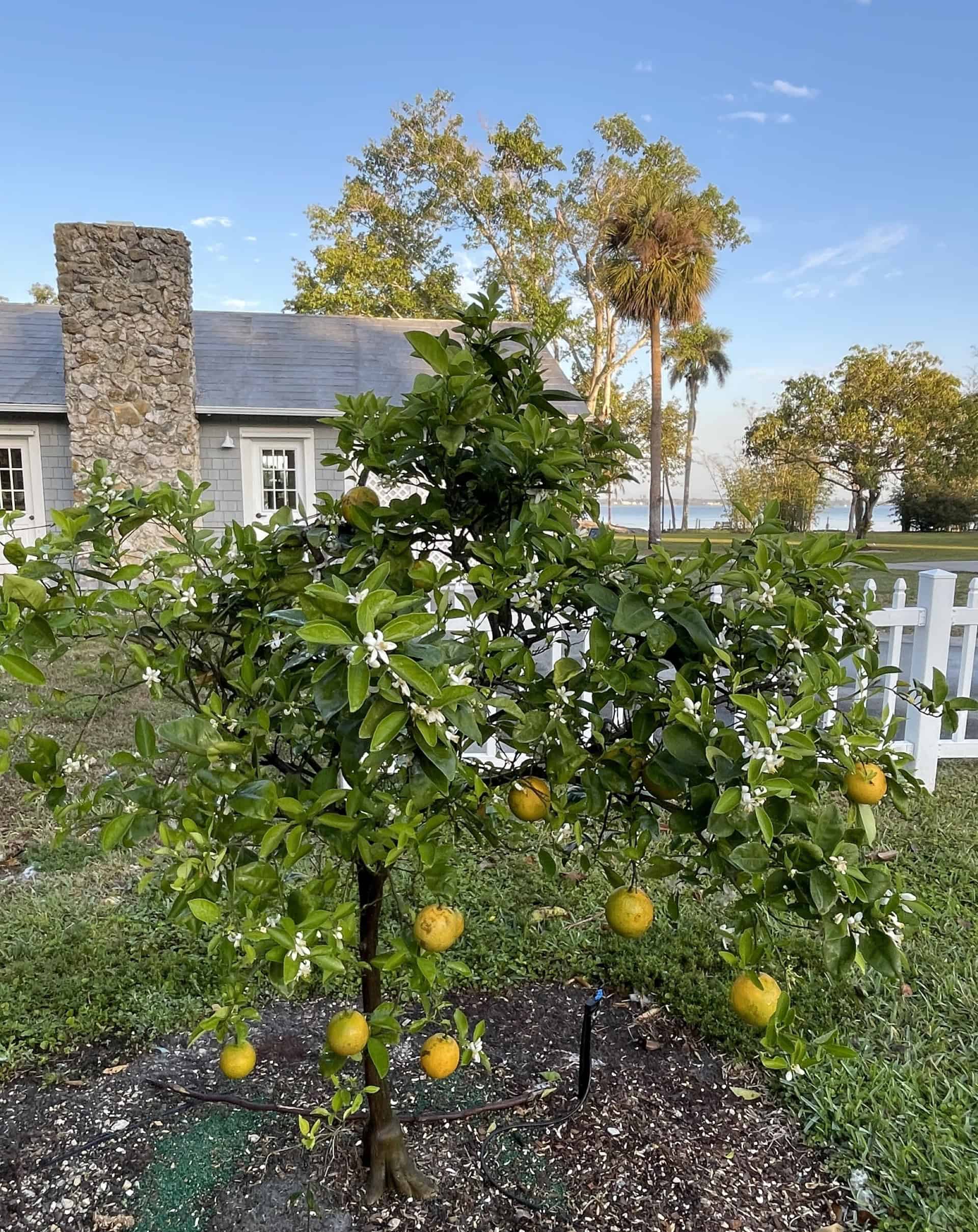
A CITRUS TREE ON THE FORD PROPERTY AT THE ESTATES WITH LAST YEAR’S FRUIT
Recently, a team from the University of Florida/Institute of Food and Agricultural Sciences (UF/IFAS) in Immokalee visited Edison and Ford Winter Estates to discuss the work they are doing on behalf of the estates to save the Henry Ford citrus grove that was planted in 2019. Over the years, the historic citrus has all but disappeared from our site; however, with the help of UF, this important chapter of our garden’s history is being restored.
Through the years, the fragrance of citrus blooms would have been a strong element of the estates as far back as 1892. When Henry Ford originally purchased his Fort Myers property in 1916, the seller and Edison neighbor, Robert Smith of New York City, boasted that his property included “100 grapefruit trees, 50 orange trees, mangos, lemons, and limes.”
Earlier records indicate that upon purchasing his property, citrus was among the first trees Edison had planted. By 1917, it was recorded that nearly 300 fruit trees grew on both lots, meaning the east and west sides of McGregor Boulevard. Inventories of the time show 98 grapefruit trees, 59 orange trees, 10 tangerines, assorted lemons and limes and in 1929, kumquats were added. A review of old planting maps reveals an extensive network of citrus surrounding the caretaker cottage and Edison home. The Edisons frequently had Fort Myers caretakers ship boxes of fruit to their New Jersey residence, as well as to friends such as the Fords in Michigan.
The Edisons had issues with citrus, such as hurricanes and freezing temperatures that devastated fruit crops. Mina Edison championed her citrus trees and always included “fertilizing the citrus” on caretaker work orders, while Thomas insured plenty of trench irrigation to keep trees supplied with water.
A total of 50 trees, predominantly Valencia oranges with a few lemon trees mixed in were planted in the new grove in 2019. The trees were grafted on citrus rootstock selected for vigor and perhaps resistance to citrus greening. A large graft is visible about eight inches above the ground on original trees. Below the graft is the rootstock and above the graft is called the scion. Grafting enables the trees to become fruit bearers in less than two years, where a seed grown citrus may take more than 12 years to produce fruit (this was a technique also employed by Edison).
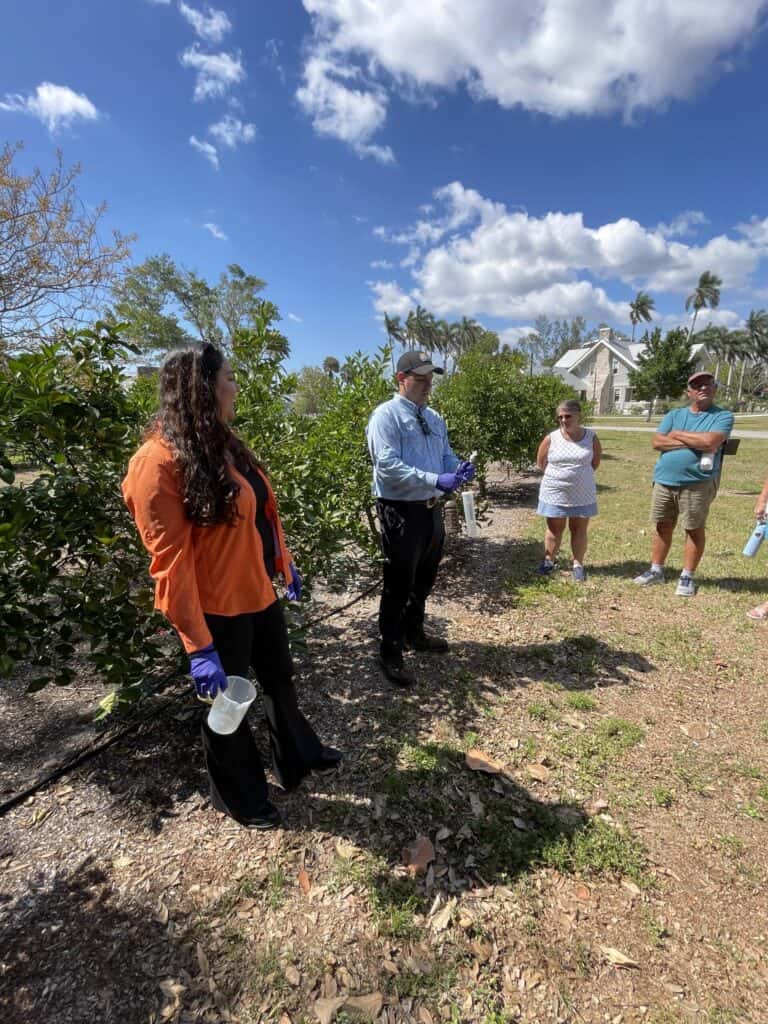
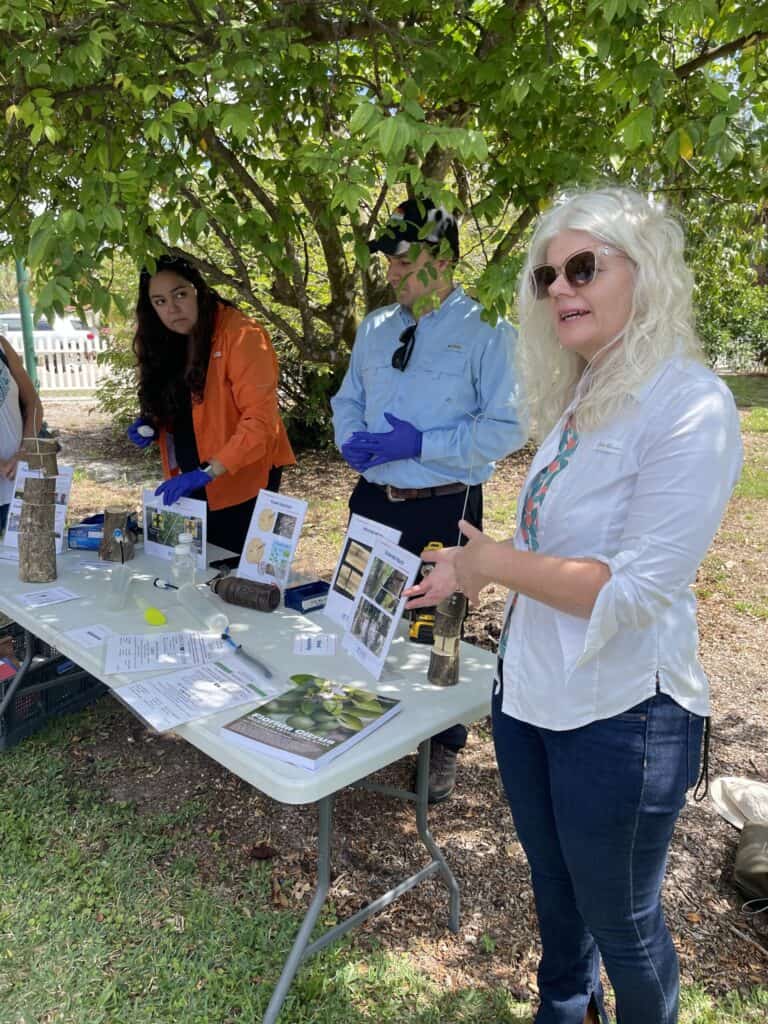
(PH.D. CANDIDATE) AND DR. UTE ALBRECHT VISIT THE ESTATES.
Of the new grove, about 20 percent have been replaced or removed. At installation, the young trees were bagged with a white net that served as a prophylactic to protect the trees from the Asian citrus psyllid – a tiny bug that carries the bacteria responsible for citrus greening or huanglongbing (HLB). As the trees increased in size, larger bags were installed to allow the trees to grow a trunk large enough to support the drilling required for the injection site.
Origins of the disease trace back to China in the late 1920s, with the disease first documented in Florida in 2005. It is possible that the disease was present earlier, because one of its symptoms – the discoloration of leaves – may have been mistaken for nutrient deficiency while concurrently, officials were busy attempting to unsuccessfully eradicate trees infected with the deadly citrus canker. Once the scientists realized that the discoloration was not evenly distributed on either side of the major vein on leaves, the random discoloration was named “blotchy mottle” and the disease was identified.
According to UF/IFAS, the popular and common periwinkle flower is easily infected with HLB-causing bacteria. Armed with this information, the readily grown plant was put through many trials of different treatments in efforts to find a cure. It turns out they responded very well to treatment with antibiotics.
As of today, there is no cure for citrus greening. Between the disease, the rapid value increase of farmlands for development and destructive hurricanes, Florida citrus production has fallen 90 percent from its highest production levels in the early 2000s.
While the disease has spread around the world, there are pockets that seem to have evaded the deadly insect. California, Europe and Chile have not yet reported the existence of the disease. Why did it hit Florida so hard? Probably because once it arrived, it was able to move without hindrance from grove to grove to grove. There are no large mountain ranges to interrupt its travel as in the areas just listed. Additionally, local weather is particularly hospitable to the Asian citrus psyllid, which prefers consistently warm temperatures and hurricane winds.
The application of antibiotics to stave off disease in trees has been used in Florida for nearly 70 years. In 2016, the Environmental Protection Agency (EPA) approved foliar application of oxytetracycline (OTC) and streptomycin for citrus trees in commercial applications. It was later discovered that the absorption rates of antibiotics were limited through the leaves due to their thick waxy coatings. Finally, in 2022, the idea of injecting directly into the stems of the trees proved much more effective and the antibiotics were taken up through the tree via its xylem – the botanical component of a tree that takes up water and minerals.
Farmers have concocted their own cost-effective method for building injectors to apply the treatment. Pictured, Ph.D. candidate Gabe Pugina applies dual injectors to distribute the OTC more quickly. Each application takes between 10 to 20 minutes, depending on the thirst of the tree. It may sound counterintuitive, but if the trees are well watered, they take up the drug much more quickly. Today, it costs farmers approximately $1.50 per tree, perhaps twice a year to administer the antibiotics. As opposed to losing their trees, it has been decided that this is a worthwhile expense – 10 trained farm hands can treat approximately 10,000 trees per grove in a day. Inoculations take place immediately after flowering and any old fruit is removed from the trees. There is a six-month waiting period following injections before new fruit is considered safe for human consumption.

DR. FRITZ ROKA (LEFT), DIRECTOROF THE CENTER FOR AGRIBUSINESS
AT THE LUTGERT COLLEGE OF BUSINESS AT FGCU, WAS ORIGINALLY
RESPONSIBLE FOR BRINGING THE UF TEAM TOGETHER WITH THE ESTATES’ CEO, MICHAEL FLANDERS, TO ENABLE THE INOCULATION PROJECT AT NO COST TO THE ESTATES. ROKA SHARED THAT UNTIL THE TREES REGAIN THEIR ECONOMIC VIABILITY WITH STABLE PRODUCTION OF FRUIT, FARMERS WILL BE HESITANT TO REPLANT THEIR ACREAGE WITH CITRUS. OBSERVING THE PROGRESS OF THE TREES AT THE
ESTATES, ALONG WITH ROKA WAS RON HAMEL (RIGHT), EXECUTIVE VICE PRESIDENT AND GENERAL MANAGER (RET.) OF THE GULF CITRUS GROWERS.
To date, there is no do-it-yourself kit for the homeowner because procurement of agricultural antibiotics requires a pesticide license due to obvious concerns about the potential consequences of improper use or misapplication of antibiotics.
Two of the biggest fans of the work being undertaken by UF/IFAS/Immokalee recently visited the estates to observe the progress. Dr. Fritz Roka, director of the Center for Agribusiness at the Lutgert College of Business at FGCU, was originally responsible for bringing the UF team together with the estates’ CEO, Michael Flanders, to enable the inoculation project at no cost to the estates. Dr. Roka shared that until the trees regain their economic viability with stable production of fruit, farmers will be hesitant to replant their acreage with citrus. Observing the progress of the trees at the estates, along with Roka was Ron Hamel, executive vice president and general manager (ret.) of the Gulf Citrus Growers. Their dedication to the industry is obvious and it was wonderful to observe their satisfaction with the progress and growth exhibited within the Henry Ford Citrus Grove.
For anyone interested in the citrus research programs, IFAS/Immokalee is extending an invitation to their Citrus Open House to be held on Wednesday, November 19, where guests can meet the scientists and learn more about their research.
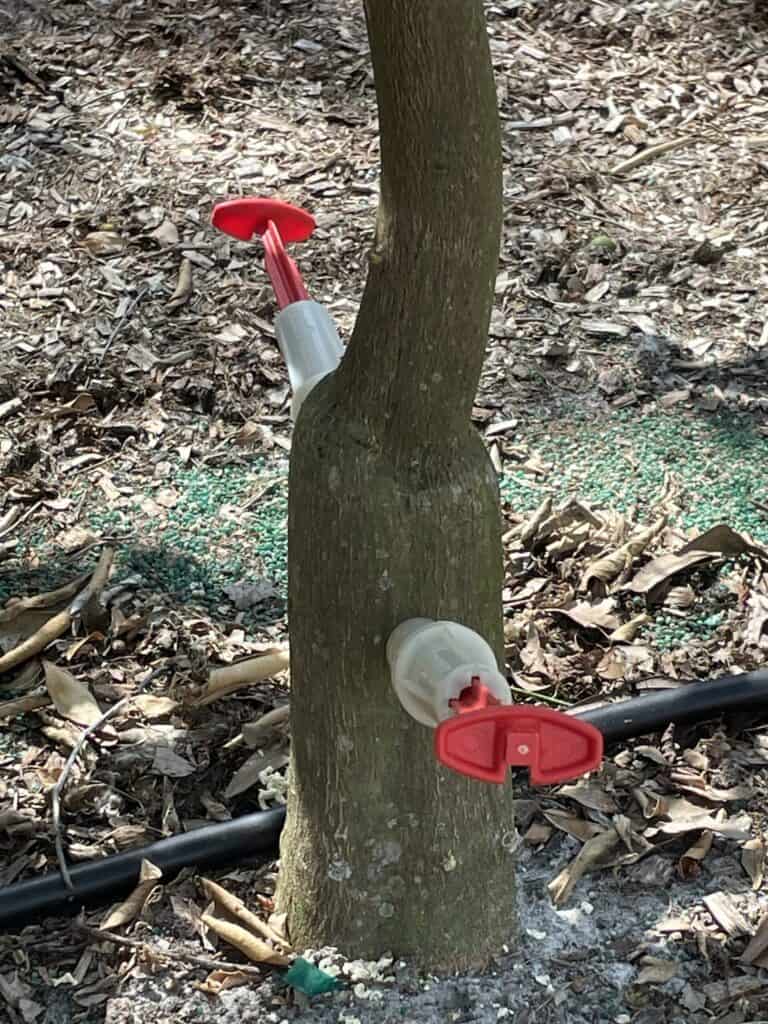
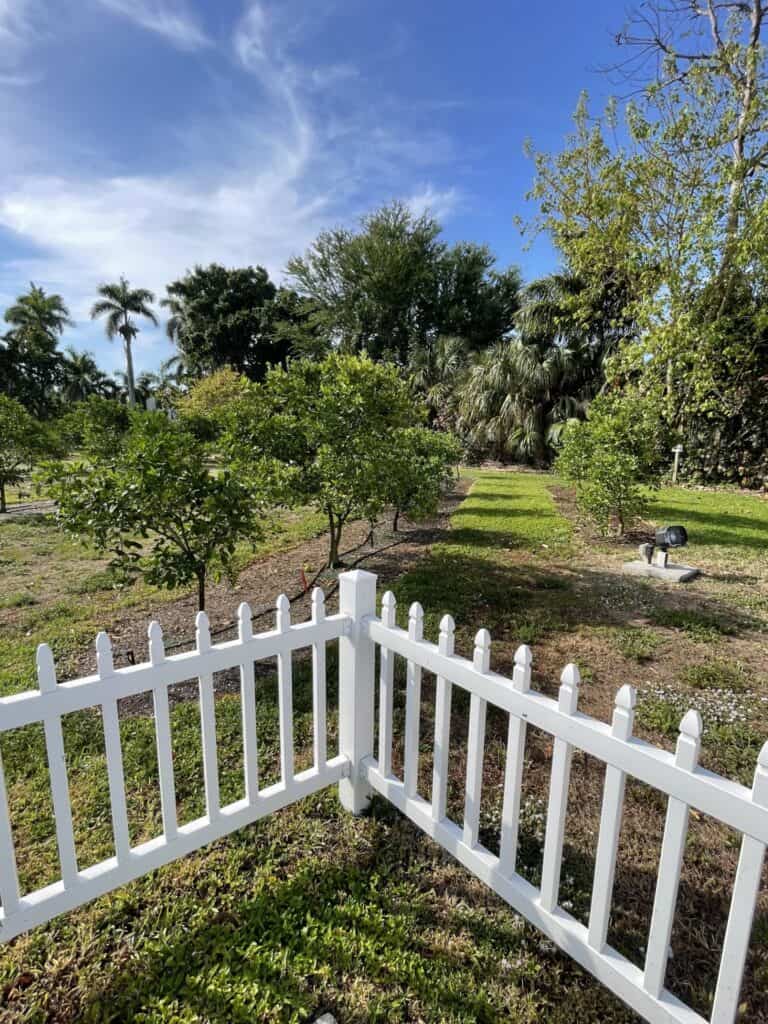
PRODUCING CITRUS.

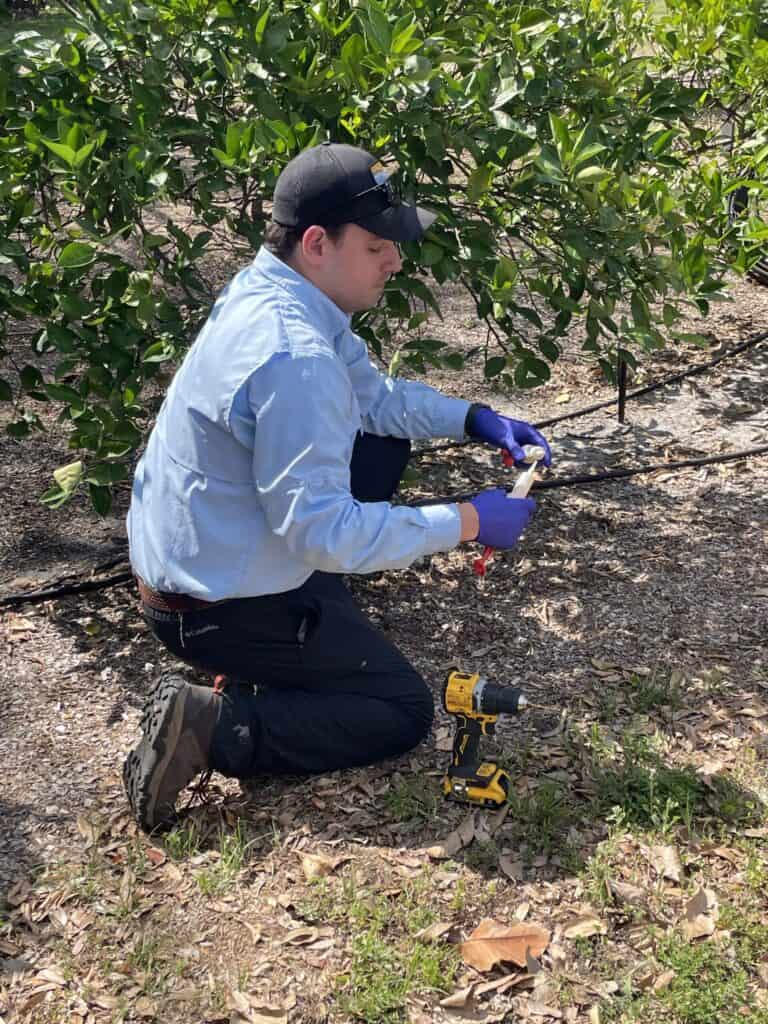
PREPARES AND INJECTS CITRUS AT
THE ESTATES WITH ANTIBIOTICS TO
HELP FIGHT CITRUS GREENING.






